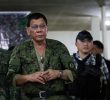
Cleaning her space inside the covered gym in Saguiaran town, Lanao del Sur on Thursday, October 19, 2017, a woman evacuee from Marawi City says she wants to go home soon, but worries about her lack of livelihood. (Lorie Ann A. Cascaro/davaotoday.com)
MARAWI CITY, Philippines — Displaced residents in the cleared areas of this city have already returned to their homes, said the deputy commander of Joint Task Force Ranao on Thursday, October 19.
In an interview, Col Romeo Brawner, Jr. said returning residents belong to Clusters 2 and 3, including the barangays near the Mindanao State University and in the northeast part of the city, adding that Cluster 1 is in the northern part outside the city, where nobody evacuated.
The controlled areas are composed of six clusters with 40 barangays, he said. Restoration of residents from Cluster 4, which is in the south areas adjacent to the Lake Lanao, is scheduled on October 26. It will be followed by Cluster 5, which includes the houses surrounding the city hall, in the first week of November.
The reopening of villages to displaced residents began after President Rodrigo Duterte declared on Tuesday, October 17 that Marawi was already liberated from the influence of terrorists. Duterte made the announcement the day after soldiers reported the death of Abu Sayyaf leader Isnilon Hapilon and a leader of Islamic State-inspired Maute group, Omar Maute, on October 16.
Meanwhile, Moro groups are calling on the government to pull out forces.
In a press statement on Thursday, the Suara Bangsamoro and Tindeg Ranao, consisting of Maranao evacuees, wanted the government to end the martial law and said evacuees who want to return to their homes “were afraid of military reprisal should they decide to file cases or hold responsible the government for the destruction of their communities.”
Their displacement for more than four months was “due to intensive military airstrike which became the response to suppress the Dawlah Islamiya (Islamic State),” the groups said.
Brawner said the 1st Infantry Battalion of the Armed Forces of the Philippines (AFP) left Marawi today, October 20, for the 31st Association of Southeast Asian Nations Summit next month in Metro Manila.
The remaining troops were still enough to fight against 20 Maute members in the war zone, he added.
He added that lifting of martial law “depends on the President’s decision” and added that “there are still other problems after the Marawi crisis, such as the Abu Sayyaf in Basilan and Jolo, the Bangsamoro Islamic Freedom Fighters in Maguindanao and the New People’s Army in Davao and Surigao provinces”.
Due to the continuing martial law and their role as “architects” of the rehabilitation here, the AFP, “aided by foreign troops including the United States military”, are replacing the “terrorists” as being in control of the city, the Moro groups said.
“These policies and actions undermine efforts for resolving conflict in Moro areas and push more Moro people to fight against fascist policies,” the groups added.(davaotoday.com)









